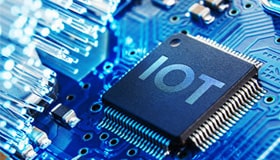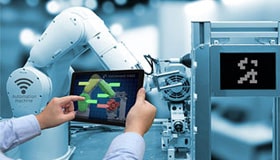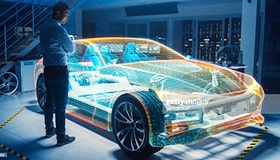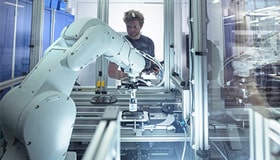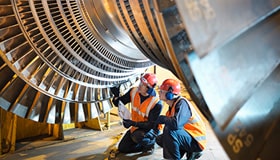
How Arduino turns open-source values into maximized motor efficiency
There is a huge opportunity to save energy by optimizing the efficiency of electric motors and associated devices, both to slash operational costs and to shrink our carbon footprint.
On the other hand, electric motor systems – often old and inefficient – command a significant 70% share of the electricity demand in industries that rely on motors and drives. On the other, the IEA has emphasized that over 40% of the reduction in greenhouse gas emissions required to align with the Paris Agreement by 2040 and reach climate goals could be achieved through enhanced energy efficiency measures. With hundreds of millions of motor-driven systems currently in use by industries across the world, the impact of higher-efficiency equipment cannot be ignored.
VFDs and the future of efficiency
Variable-frequency drives (VFDs) drive electric motors by varying the frequency and voltage of their power supply, and have become extremely common assets on the factory floor – anywhere varying motor speed is essential, such as in pumps, fans, and conveyor systems. Continuously evolving with a focus on energy efficiency, these types of controllers are being integrated with advanced algorithms and features to improve their precision and flexibility. Being able to better monitor and control motor speed, torque, and overall performance leads to enhanced efficiency and reduced consumption, as well as lessened wear and tear over time. All of this contributes to optimize motor performance and lower operational costs.
What’s more, VFDs are playing an increasingly important role in the Industrial Internet of Things (IIoT) involving Industry 4.0 and 5.0 systems, which allow for remote monitoring, real-time analytics, and predictive maintenance. The data collected from VFDs can thus be used to further enhance overall system performance and reliability. And while cybersecurity is a critical concern for any connected or smart industrial system, strategies such as encryption, authentication protocols, and other measures are being widely implemented to ensure the integrity and confidentiality of data exchanged between VFDs and control systems.
Finally, the integration of VFDs into existing systems through upgrades or expansions is becoming easier as manufacturers develop modular and scalable VFD designs, adding flexibility in terms of configuration and making it easier for big and small enterprises to adapt to changing requirements even in the future.
5 trends in VFDdevelopment
- Energy efficiency and sustainability
- Integration with IoT, Industry 4.0, and Industry 5.0
- Advanced motor control algorithms
- Modular and scalable designs
- Cybersecurity measures
Pairing VFDs and PLCs for predictive maintenance
When VFDs and Programmable Logic Controllers (PLCs) work together in industrial automation systems, various processes and components can be monitored and controlled to achieve the most efficient and reliable operation – leveraging data originated from sensors on the edge, control signals and feedback loops for real-time adjustments and optimizations. In addition, PLCs can process data gathered from VFDs to identify potential issues before they lead to wasted resources and unplanned downtime.
That was exactly the goal AROL – a leading capping machine manufacturer based in Canelli, Italy, with over 25,000 pieces of equipment currently installed around the world – set out to achieve. With production lines processing up to 100,000 bottles per hour, maintaining their machines’ speed and ongoing reliability is critical to operations. In other words, any outage or unplanned downtime would be detrimental to meeting production quotas and costly to their clients.
Therefore, their R&D team decided to integrate diagnostic, prognostic, and predictive maintenance capabilities into a smart solution able to gather data from industrial equipment and the surrounding environment, creating a machine monitoring system based on remote wireless sensors that could be powered by battery or 24 V.

The project faced specific challenges in the fact that the sensor nodes had to be mounted in rotating capping turrets, fitting in a small space, and yet always remaining connected to a communication unit at the base of the line. What’s more, they had to perform part of the data processing on the edge, in order to not overload the central system. And of course, the upgraded capping machine had to be made smart without costing sensibly more.
Fortunately, a solution was on hand: leveraging Arduino Pro’s Nicla Sense ME and Portenta Machine Control helped AROL expedite efforts to a working solution – one that completely avoided vendor lock-in while also upgrading their high-speed production equipment to enable data monitoring and predictive maintenance outcomes.
No less than 15 capping turrets were fitted with as many Nicla Sense MEs, providing vibration and temperature detection thanks to state-of-the-art, onboard Bosch Sensortec sensors – as well as the computational power to process part of the data directly at the level of the sensing nodes. At the base of the machine, one Portenta Machine Control was easily mounted on DIN rail to concentrate communication with all the sensors via Bluetooth®.
Arduino Pro’s Nicla Sense ME (where 'ME' stands for 'Motion' and 'Environment') is a compact module that brings sensing and intelligence at the edge with a 9DoF smart motion sensor and a 4DoF environmental sensor with AI capabilities. Thanks to its high computational power, it reduces latency and power consumption, offers more privacy, and requires less bandwidth – all in a tiny physical footprint.

Arduino Pro’s Portenta Machine Control is a fully-centralized, low-power, industrial control unit able to drive equipment and machinery – a “brain” that can be programmed using the Arduino framework or other embedded development platforms, to collect real-time data from the factory floor and support the remote control of equipment, even from the Cloud when desired.

'In AROL’s case, the Portenta Machine Control was the best choice due to its 32 I/Os, while less articulated systems might benefit from the enhanced flexibility of Arduino Pro’s new Opta micro PLC solutions based on the same STM32H747XI Dual ARM® Cortex® processor and programmable using C++ in Arduino sketches, as well as having the flexibility of incorporating any or all of the 5 traditional automation control languages defined by the IEC 61131-3 standard (Ladder, Functional Block Diagram, Structured Text, Sequential Function Chart, or Instruction List).
Why choose open source to optimize your VFD?
Arduino’s open-source approach to both software and hardware sets the company apart from all other players in the tech field. What started as a philosophical stance has developed, over time, into the source of a wide array of business benefits for professional clients around the world.
In terms of ensuring no vendor lock-in, greater interoperability, and a reduced energy footprint, for example, choosing Arduino’s products can further increase a solution's efficiency thanks to the company’s strong focus on low-consumption and small form factor options. The entire Nicla family, for example, packs industrial-grade sensors and computing power into a mere 22.86x22.86 mm (about the size of a thumb!).
In addition, Arduino’s offering brings edge computing into anyone’s reach. Processing data where things happen enables the kind of real-time monitoring and control we saw can make a difference for a system’s efficiency; in and of itself, it also helps save energy directly by reducing data sent to the Cloud, thereby reducing cloud consumption costs. Leveraging the Arduino ecosystem and open architecture, edge computing becomes more affordable – thanks to cost-effective solutions that optimize the bill of materials – as well as more accessible for engineers, who can count on great ease-of-use, extensive public documentation and resources, and the choice among a variety of possible coding languages.
In general, Arduino products adhere to widespread industry standards, promoting interoperability between different devices and systems. This, in turn, ensures better compatibility and avoids vendor lock-in – making an open-source solution future-proof.
The flexibility and opportunity for customization of open-source solutions can be particularly valuable when integrating VFDs and PLC capabilities into complex automation systems, as they allow for the fine-tuning of control algorithms, interfaces, and more to meet specific project requirements and adapt to unique industrial processes.
Where security and reliability are paramount, open-source solutions can be more transparent: this can allow developers to identify and fix vulnerabilities faster. Arduino’s products undergo strict quality controls and are tested to the highest standards. The Arduino Pro Opta, for example, has been recently put through a cybersecurity posture assessment, resulting in upgrades that make it more reliable than ever.
Last but not least, choosing open-source technology for motor control solutions means tapping into a pool of expertise and support from a vibrant community – over 33 million active users, in the case of Arduino. This can lead to faster issue resolution, continuous improvement, and the availability of a wealth of resources, including forums, documentation, and contributed code.
'All in all, whether saving energy is a key global strategy to counter climate change or a necessity to reduce costs and maintain your own competitive edge, optimizing motor efficiency with VFDs paired with Arduino controllers opens up a variety of benefits you cannot afford to waste.
5 Reasons to choose open source for efficient motor control
- Cost-effective development
- Community support and shared knowledge
- Flexibility and customization
- Interoperability and standards compliance
- Transparency and security
CONCLUSION
Learn more about industrial-grade Nicla intelligent sensing and the Portenta family with Industrial IoT capabilities optimizing motor efficiency. Click here
Featured products
Portenta Boards: Arduino’s series of high performance industry rated boardsPortenta Machine Control: A fully centralised, low-power, industrial control unit able to drive equipment and machinery.
Nicla Family: Arduino’s tiniest industrial oriented board
Download article in PDF
